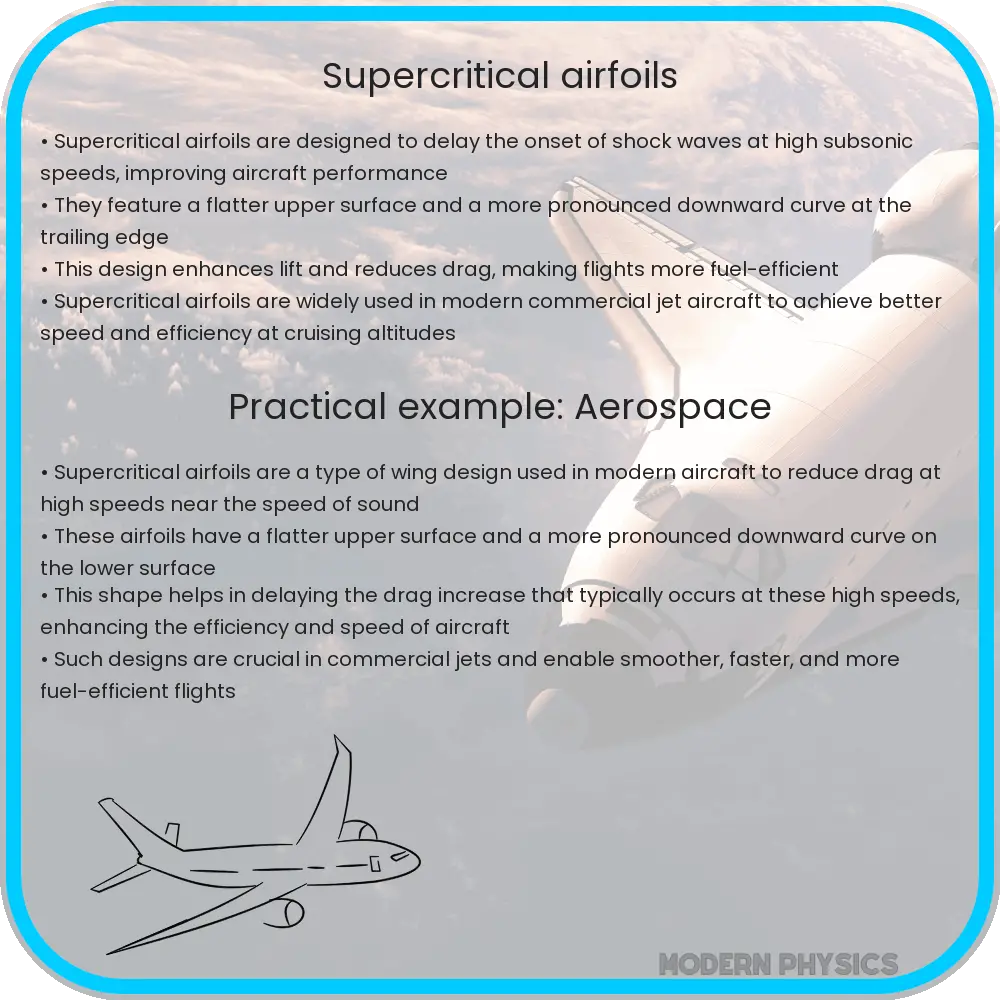Understanding the design and benefits of supercritical airfoils in modern aviation for enhanced aircraft performance.

Understanding Supercritical Airfoils: Enhancing Aircraft Performance
Supercritical airfoils represent a significant advancement in aircraft wing design, pushing the limits of efficiency, speed, and lift dynamics. Developed primarily to delay the onset of drag-inducing shock waves at high subsonic speeds, these airfoils facilitate better performance characteristics in faster aircraft. This article explores the design, benefits, and overall impact of supercritical airfoils in modern aviation.
Design Features of Supercritical Airfoils
In traditional airfoil profiles, the objective has often been to maximize the lift at lower speeds, suitable for take-offs and landings. However, as aircraft speeds approach the speed of sound (approximately 343 meters per second at sea level), shock waves can form, significantly increasing drag and reducing efficiency. To address these challenges, supercritical airfoils are designed with specific features:
- Flattened Upper Surface: This helps in reducing the adverse pressure gradients and delays the onset of upper surface shock waves.
- Larger Leading Edge Radius: This feature aids in managing higher airflow speeds and minimizes the formation of strong shock waves.
- Rearward Camber: By adjusting the camber near the trailing edge, supercritical airfoils enable better control over lift and drag characteristics at high speeds.
These modifications result in an airfoil that performs more efficiently at near-sonic and transonic speeds, typifying modern commercial and military jet performance requirements.
Efficiency at High Speeds
One of the primary advantages of supercritical airfoils is their ability to operate efficiently at high subsonic speeds. The design reduces wave drag, a form of aerodynamic drag that forms when an aircraft approaches and exceeds the speed of sound. The flattened upper surface of the airfoil plays a critical role here, helping to spread out the shock waves that contribute to increased drag. This distribution of shock waves results in a smaller wave drag footprint, enabling the aircraft to maintain higher speeds without a significant increase in fuel consumption.
Additionally, by meticulously shaping the leading edge and the aft portion of the airfoil, supercritical designs facilitate smoother airflow around the wing, diminishing energy losses caused by turbulent flow separations. Such efficiency improvements are not only crucial for performance but also for reducing operational costs and environmental impact.
Lift Dynamics in Supercritical Airfoils
While the focus on delaying shockwaves is vital, supercritical airfoils also excel in managing lift. Lift generation is crucial for any aircraft, as it counteracts the gravitational forces pulling it towards the Earth. The unique rearward camber and larger leading edge radius enhance the airfoil’s ability to generate lift even at higher speeds, where traditional designs might falter due to shockwave-induced separation of the airflow.
The structural integrity of the airfoil allows it to tolerate higher aerodynamic loads, fostering greater stability and control at speeds close to the sound barrier. Thus, supercritical airfoils not only improve high-speed performance but also enhance the aircraft’s overall aerodynamic efficiency across various flight regimes.
Applications in Modern Aviation
Supercritical airfoils are not just theoretical constructs but are integral to many modern aircraft designs. From commercial airliners like the Boeing 787 Dreamliner to military jets such as the F-22 Raptor, these airfoils are employed to achieve optimal performance. The benefits of reduced drag and improved lift characteristics make supercritical airfoils suitable for a wide range of aviation applications, emphasizing their versatility and effectiveness in modern aerospace engineering.
Moreover, the use of supercritical airfoils extends beyond fixed-wing aircraft. Experimental projects and advanced UAVs (Unmanned Aerial Vehicles) also utilize these designs to enhance efficiency and performance in challenging flight conditions. Their application in supersonic and hypersonic test vehicles further underscores the potential of supercritical airfoils in pushing the boundaries of aviation technology.
Future Prospects
As aviation technology continues to evolve, the role of supercritical airfoils is expected to expand further. Future research may focus on refining these airfoil shapes through computational fluid dynamics simulations and wind tunnel testing. Additionally, the integration of new materials and construction techniques could allow for even more efficient and lightweight airfoil designs.
This ongoing innovation will likely pave the way for more environmentally friendly aircraft that do not compromise on speed or efficiency. The potential for these airfoils in reducing the overall carbon footprint of the aviation industry is immense, aligning with global efforts to combat climate change and minimize environmental impact.
Conclusion
Supercritical airfoils represent a cornerstone in contemporary aircraft design, offering a revolutionary approach to handling the challenges of high-speed flight. By cleverly modifying wing profiles to manage shock waves and improve lift, these airfoils enhance the efficiency, speed, and environmental sustainability of aircraft. As aviation continues to progress, supercritical airfoils will play a pivotal role in shaping the future of aerospace technology, making air travel faster, safer, and more economical. With their broad applicability and potential for development, supercritical airfoils stand as a testament to the dynamic nature of engineering innovation in the quest for superior air travel solutions.
